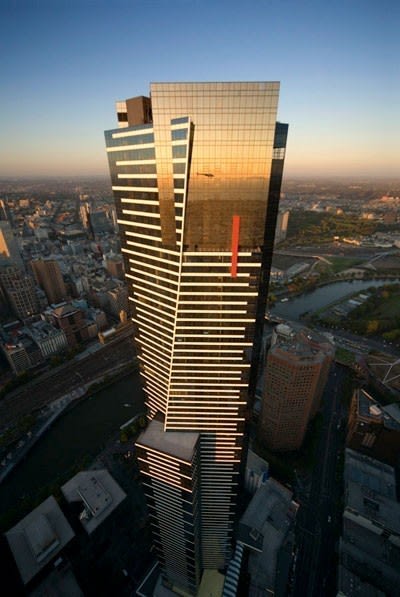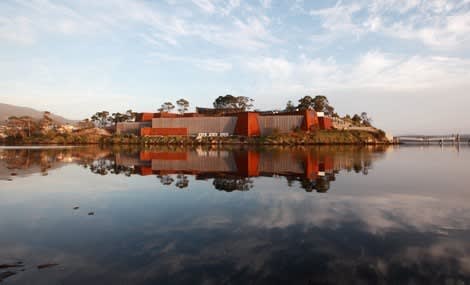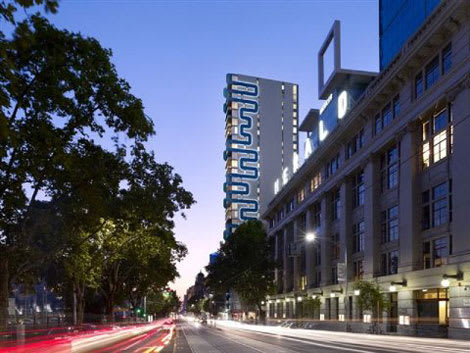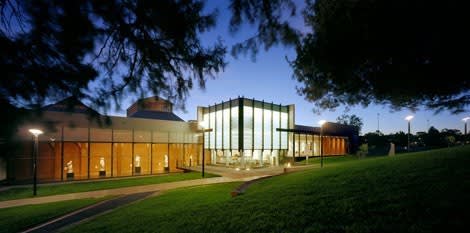Onwards and upwards in Kuala Lumpur for Fender Katsalidis after Eureka moment
As we look to what's ahead for 2012, Property Observer is republishing some of our most noteworthy stories of 2011.
With the success of the Melbourne Terrace Apartments, a newly established firm and several landmark buildings under its belt, the big-ticket commissions began rolling in for Fender Katsalidis.

There was the Richmond Silos (pictured above), converted from old grain silos and built in 1996, the Ian Potter centre (1998), the Republic Tower, HM@S Tower (pictured below) and Bendigo Art Gallery (1999), and New Quay at Docklands (2004).

But one building would say more about the ambition of Fender Katsalidis than any other – a gleaming, gold-tipped pillar called the Eureka Tower, which at 92 storeys Nonda Katsalidis insists is “still the tallest building in the country”, despite that title officially belonging to Q1 on the Gold Coast. (To set the record straight, Katsalidis says the roof height of Q1 is 275 metres, Eureka’s is 297, he reckons Q1 cheated by adding a 45-metre spire on top, “but let’s not start that argument again!”.)

Katsalidis says designing the Eureka Tower (pictured above), which turns five years old this month, was always about creating “an iconic, huge thing”, and the firm certainly achieved that.
When awarding Eureka Tower the Royal Australian Institute of Architects Harry Seidler Award for Commercial Architecture in 2007, the jury said it “clearly demonstrates that commercial architecture can be about more than the ‘bottom line’ – it can contribute a broader value to the life and character of the city”.
And Eureka Tower’s bottom line is still doing just fine. According to end-of-financial-year reports for 2010 compiled by Harcourts City Residential, the average selling price for apartments in the Eureka Tower in 2010 was just under $1.047 million, up from $707,685 the previous year. The median sale price for Southbank apartments in 2010 was $602,900.
Katsalidis is coy about Eureka’s financial success. “It’s still the slickest-looking building in Melbourne,” he says. “It’s a very striking building; it’s used as the backdrop in the news and is a symbol for
With Eureka under its belt and its stamp firmly placed on Melbourne, Fender Katsalidis set about looking for opportunities outside the city where the firm made their name.

Katsalidis says his most recent highlight was designing entrepreneur David Walsh’s “adult
MONA aside, the majority of Fender Katsalidis’ work is still focused on creating new residential possibilities, with much of its work being on large planning projects, even designing entire cities.

In
In Dubai, the firm consulted on the much talked-about Palm Jebel Ali, a reclaimed island designed to resemble the fronds of a palm tree, which developer Nakheel still hopes will house more than 250,000 people by 2020 although construction on the development has stalled. The firm was involved in some of
Karl Fender, quoted in a 2009 article about the Dubai crash in The Age, said “Dubai was a place in a hurry. It was based on a hard-to-define marketplace, and built on a frenzy of speculation.”
Despite Dubai’s well-documented property crash, its initial boom gave Fender Katsalidis architects the chance to push their design skills and imagination to a new level.
Today, the firm hires nearly 100 staff, but Katsalidis says he and Fender are still personally involved in every project and they are still as ambitious as ever. Their reach is now global, but they still call Melbourne home and aren’t done there yet.

Not just happy to build the tallest skyscraper in Melbourne, now the pair want to design the slimmest.
Maxx apartments in St Kilda has just begun construction and will be a mixed-use development incorporating two commercial storeys and 11 residential. Apartment prices range from $387,000 to $640,000.

Fender has also been invited back to the Bendigo Art Gallery (pictured above) to assist with a $7.55 million expansion it hopes will give it more room to host big-name exhibitions.
Fender, who over the years has called the Melbourne Terrace Apartments, the
Fender Katsalidis’ most ambitious, or at least tallest, building is still to come. Katsalidis is tight-lipped on details, but confirms the firm has been commissioned to design a 100-storey, 500-metre skyscraper in Kuala Lumpur in mid-2012. It will be the firm’s tallest yet and just scrape through to be the second tallest building in the world. Further proof perhaps that Fender Katsalidis’ rising ambition is far from satisfied.
